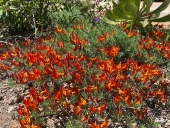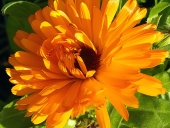I could use some help...
In our hot and dry mediterranean food forest in Tenerife (Canary Island) we are in altitude of 1,200m/4,000ft.
We're "employing" mainly 4 nitrogen fixing trees (one of them is on constant debate - if it's really fixing nitrogen).
I would love to learn from you what nitrogen fixing trees work in your mediterranean garden or food forest.
We use the nitrogen fixing trees by:
Planting them in our food forest to feed nearby fruit or nut trees.Pruning these trees regularly and use the cuttings as mulch around fruit trees and perennials to feed the soil from above.Composting the cuttings to create a rich soil amendment for vegetable gardens.
If you have other ways to use them - I'd love to hear from you...
These are our favorite mediterranean nitrogen fixing trees:
 Carob (Ceratonia siliqua)
Carob (Ceratonia siliqua)
Traditionally, carob pulp has been used for food: roasted and eaten as a snack, roasted and ground to make a cocoa substitute, fermented to make alcohol, or diluted to make carob syrup.
Carob trees also provide a wood used for making utensils and slow-burning charcoal.
While previously not believed to be a nitrogen-fixing tree, carob trees have been identified lately with nodules containing bacteria believed to be from the Rhizobium genus – which earns it the place in our list of mediterranean nitrogen-fixing trees.
 Sweet Acacia (Acacia farnesiana)
Sweet Acacia (Acacia farnesiana)
A beautiful nitrogen-fixing tree with sweet smelling, bright yellow flowers used in French perfumes and a favorite of our honeybees and other pollinators.
 Coojong (Acacia saligna)
Coojong (Acacia saligna)
A small and very productive nitrogen-fixing tree that produces every year a large quantity of woody biomass.
We use the branches, twigs and leaves for mulching and the thicker branches as firewood.
But our mediterranean nitrogen-fixer tree star is the…
 Tagasaste (Chamaecytisus palmensis)
Tagasaste (Chamaecytisus palmensis)
Tagasaste (or Tree Lucerne) is an indigenous small nitrogen-fixing legume tree from La Palma (Canary Island).
White flowers appear in the end of winter and spring. The flowers develop into flattened pods about 5 cm long, containing about 10 seeds.
Tagasaste tick almost all the boxes as a multipurpose tree.
Except feeding us, it can be used for almost anything:
Agroforestry
As tagasaste is a deep-rooting perennial, it taps nutrients in the subsoil and transport these to the topsoil in the form of dropped leaves and twigs.
This and nitrogen fixing are the reasons why we plant tagasaste everywhere in our food forest.
Bee Forage
Tagasaste provides valuable nectar and honey in late winter when our bees have very little flowers to forage.
Fodder
Currently, the main use of tagasaste (mainly in Australia and New Zealand) is fodder for livestock and it is comparable to pasture and hay.
Our chicken devour the tagasaste leaves.
Shelter
Mature tagasaste trees provide good shade and, if grown in closely planted hedgerows, create an excellent windbreak.
We plant a circle of tagasaste plants around a wind-sensitive young trees (e.g. walnut), and remove the shelter plants after a few years.
Timber
Tagasaste timber is quite dense and suitable for manufacturing small objects.
We use the thicker branches for firewood.
Conservation and Reclamation
The ease with which tagasaste can be established and its rapid growth rate make it an extremely valuable plant for revegetating eroded areas.
Landscaping
And last, but not least. tagasaste is a beautiful evergreen tree with masses of white flowers.
I would love to learn from you what nitrogen fixing trees work in your mediterranean garden or food forest.
Thank you.

 9
9








 3
3





 3
3




 3
3












 2
2












